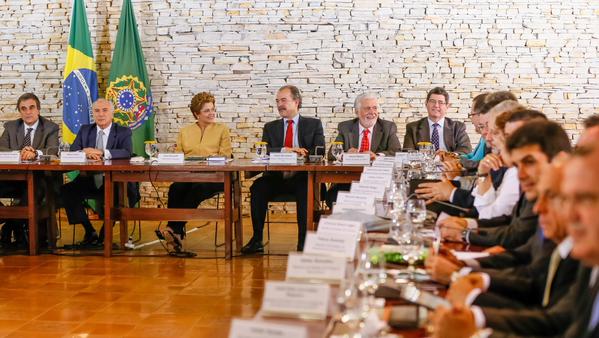

Follow us on:  
|

President Dilma Rousseff, in her first mandate, attempted to implement a reliable economic growth policy to protect the Brazilian economy from the effects of the global recession. At the time, there was higher disposable income resulting in consumer demand to respond to such an objective. The policy strategy was based on fiscal and credit expansion, as well as the removal of the payroll tax in 56 industrial sectors, a broad tax decrease in both consumer goods and energy tariffs, aiming to revamp Brazilian growth and employment rates.
It did NOT succeed.
It ended up in a larger fiscal deficit, higher inflationary pressure, an unstable monetary policy, and an unpredictable exchange rate.
What led to this state of affairs? A simple explanation would be – the duration of government stimulus remained for too long, boosting social demand for consumer goods and services over three years.
There was a demand and supply mismatch of the industrial production and logistics capacity. Demand above supply resulted in higher inflation and interest rates, and exchange rate appreciation.
In the end, by 2014, it engendered in higher consumer indebtedness, a higher rate of commercial bank delinquency for consumer credit, lower growth and larger federal and state debt. No wonder then that investors remained skeptical about Brazil’s growth prospects.
During President Dilma Rousseff re-election campaign, there was considerable political turmoil. Most political analysts wrote her off.
Defying all political punditry, she ended up being reelected.

Brazilian President Dilma Rousseff (3rd from left) with her newly sworn-in Cabinet Ministers, including Finance Minister Joaquim Levy (extreme right).
Now with a fresh second mandate, she faces an acute challenge of restoring the government’s credibility with domestic and foreign investors.
Interestingly enough, the current economic policy program proposed by President Dilma was neither presented nor debated during the high-pitch presidential political campaign.
It is far from any previously imaginable political and economic reforms proposed by her party. The neoliberal opposition political party, PSDB, is angry about President Dilma´s economic program since it contains some of their avowed basic neoliberal economic principles, in particular, the fiscal adjustments.
Conversely, President Dilma´s fiscal adjustments and tight monetary policy to reduce inflation and the cost of capital caused some disappointment even in her own political party, the Labor Party. They expected an equivalent program used during her first term in office to be re-implemented. All in the name of economic growth, that didn´t really flourish in the past couple of years.
Instead, President Dilma has opted to save her political legacy as a developmentalist based on a solid fiscal and pragmatic base.
The new economic policy, announced by her team, seems to be a neoliberal one, but it is not. Pragmatically, the Brazilian economic policy reversal represents what has to be done in order to ascertain fiscal stability and sound monetary policy to restore investor´s confidence in Brazil’s future.
The new economic ministers, Joaquim Levy, Minister of Finance, Nelson Barbosa, Minister of Planning, and Alexandre Tombini, Chairman of the Brazilian Central Bank, have the mission to rebalance the federal budget, remove most of the subsidies stimulus for consumer demand, and readjust all prices managed by the federal government.
However, they must be acutely aware that the budget equilibrium will not be achieved by cutting federal expenses alone, but also by some tax increases, public price adjustments (hydro energy, oil and gas), as well as the price of public transportation and utilities.
Nonetheless, it will cause a mild recession this year and Brazilians must brace for it.
However, the Brazilian federal government´s fiscal realism will strengthen the monetary policy mandate to maintain control over the local currency´s purchasing power, reducing both costs of capital and production. Only then, will it be possible to plan for stable and higher economic growth.
The new economic policy by Rousseff’s re-calibrated team is already working to bring fiscal balance to an acceptable equilibrium, preliminarily, by cutting and reprioritizing federal outlays, reviewing pension for death, unemployment, and health benefits. All these fiscal measures must result in $30 billion in federal resources necessary to render a primary fiscal surplus of 1.2% of GDP this year, and 2% next year.
This fiscal re-equilibrium program is expected to reduce inflation and interest rates, reestablishing the competitiveness of the exchange rate, and stabilize expectations of basic Brazilian economic fundamentals.
Although the tight fiscal and monetary policies can offer the economy a new market equilibrium, the Petrobras scandal is bleeding the domestic and foreign investors’ portfolio, as well as the confidence in the country’s political and judiciary systems. This Brazilian graft scandal could end up being just another factor that pushes the economy into a recession.
But here’s a thought: If this is the social and economic price to be paid to restore the country´s political and economic strength, let’s do so as soon as possible. President Dilma Rousseff has nominated the Minister of Finance, Joaquim Levy, to head the restructuring the company’s new board of directors and to get its accounts certified by auditors.
For now, it’s a “wait and watch” policy for Brazil commentators as the Latin American giant scrambles to get its act right.
There’s a lot riding on the new economic policy, expected to show results in the near future. If it fails, President Dilma will her lose political support in both houses, and weaken the fragile economic recovery.